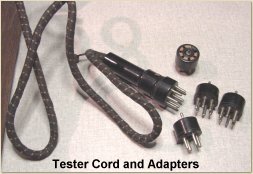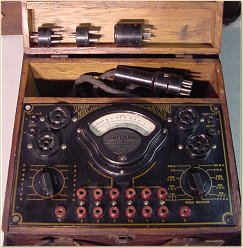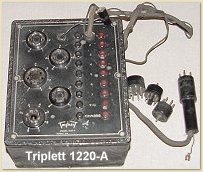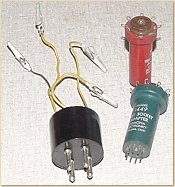

















|
 |



 Supreme Instruments Corp.
Supreme Instruments Corp.
Greenwood Mississippi
|
Free Reference Point Testing System
Supreme Instruments Corp.
From Supreme's very first testers and radio analyzers, Supreme engineers realized the importance and advantage
of not only testing a vacuum tube for its condition with a simple good or bad reading,
but also the operation of the tube in and out of the actual radio under test.
 Early radios and analyzers were battery powered. The first analyzers used the actual radio to power the tube under test.
Most early 1920's analyzers and tube testers used a long cord with a plug and several adapters to test the vacuum tubes.
The service man would remove the tube from the radio and plug the cord from the analyzer in its place using the proper adapter.
The tube would then be placed in the tester's socket and with the radio operating on its batteries, the tube could be checked
for its operation using the meters in the analyzer. This allowed meter readings to be taken from all pins on the tube.
Early radios and analyzers were battery powered. The first analyzers used the actual radio to power the tube under test.
Most early 1920's analyzers and tube testers used a long cord with a plug and several adapters to test the vacuum tubes.
The service man would remove the tube from the radio and plug the cord from the analyzer in its place using the proper adapter.
The tube would then be placed in the tester's socket and with the radio operating on its batteries, the tube could be checked
for its operation using the meters in the analyzer. This allowed meter readings to be taken from all pins on the tube.
Many of Supreme's testers and analyzers brought each pin in every socket out to a row of jacks on the tester to allow
the service man to easily hook up a meter to test input, output, and voltage.
They could also inject or test for a signal on every pin of the tube under test or the socket in the radio chassis. This method of testing
was called "Free Reference Point Testing" or "Freepoint Testing" and did not require any adapters or clips
on the socket to attach meters to the pins on a tube.
The Supreme 333 Analyzer shown at the right brought every tube pin from the test sockets out to a red, numbered jack for meter testing.
|

Supreme 333 Standard Analyzer (1934)
|
By the late 1920's radios became AC powered and although many analyzers still allowed for testing the tube in the actual radio circuit using a
cord from the analyzer, many of the newer vacuum tubes would not
function properly when moved further away from the radio circuit. Supreme for the most part discontinued using the cord in their testers in the mid 1930's but
continued to incorporate "Free Point Testing" jacks in many of their models.
 In the 1930's Triplett and other manufacturers also manufactured testers offering the "Freepoint" method of testing.
In the 1930's Triplett and other manufacturers also manufactured testers offering the "Freepoint" method of testing.
The Triplett 1220-A Free-Point Tester shown at the right was used to allow in circuit point testing of tube pins using the serviceman's Volt-Ohm-Millammeter.
Not a tube tester, the 1220-A was designed only to provide a series of tube sockets with a jack for each pin for external meter connections.
|
 Supreme continued to incorporate Free Point testing jacks on many of their testers through the 1930's. Many of the 200, 300, and 400 series Supreme testers and radio analyzers
manufactured through the 1930's provided test jacks for every tube socket pin. These were phased out in the 1940's and by the 1950's most radio servicemen had to use adapters if they wanted to connect
external meters to the pins of the tube they were testing.
Supreme continued to incorporate Free Point testing jacks on many of their testers through the 1930's. Many of the 200, 300, and 400 series Supreme testers and radio analyzers
manufactured through the 1930's provided test jacks for every tube socket pin. These were phased out in the 1940's and by the 1950's most radio servicemen had to use adapters if they wanted to connect
external meters to the pins of the tube they were testing.
Shown here are a homemade adapter for early tubes and two point test adapters from the 1960's.
|
|


Home Page
Supreme History
Tube Testers
Radio Diagnometers
Multimeters
Radio Analyzers
Advertising
Supreme Parts
Manuals & Schematics
Items Wanted
Please Note:
The data and files contained here are from many vintage sources.
There is no guarantee of the accuracy of any information or files contained on these pages.
It is solely up to the end user to decide that the information and files contained
here are accurate and fit for use with their equipment.
I am not responsible for any loss or damages that may be incurred in any way from the use of any information contained on or downloaded from this web site.
 |
This is a private collection.
This site is not affiliated in any way with Supreme Instruments Corp.,
Hickok-Supreme Inc., or Supreme Electronics of Greenwood Mississippi.
Copyright © 1995-2024 Steve Johnson, Elbridge NY, All rights reserved.
|

|
|
|

